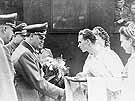
|
|
|

|

|

|

|
|
Click on an image to see a larger, more detailed picture.
|
|
|
|
|
| 1941: Mass Murder |

|
pg. 239 |

|
|
|
|
| |
 On June 22, 1941, German troops invaded the Soviet Union. Operation Barbarossa was, in the words of historian Alan Clark, "the greatest and longest land battle which mankind has ever fought." Millions of German troops stormed into Soviet territory. The campaigns in the East marked a fundamental shift in operational policy. The war against the Soviet Union was a war of annihilation, as Hitler planned to totally destroy the Bolshevik power. He used the war to unleash the murderous Einsatzgruppen. By the end of the year, more than 750,000 Jews would be killed by the Einsatzgruppen and their accomplices.
On June 22, 1941, German troops invaded the Soviet Union. Operation Barbarossa was, in the words of historian Alan Clark, "the greatest and longest land battle which mankind has ever fought." Millions of German troops stormed into Soviet territory. The campaigns in the East marked a fundamental shift in operational policy. The war against the Soviet Union was a war of annihilation, as Hitler planned to totally destroy the Bolshevik power. He used the war to unleash the murderous Einsatzgruppen. By the end of the year, more than 750,000 Jews would be killed by the Einsatzgruppen and their accomplices.
Photo: Archives of Mechanical Documentation / United States Holocaust Memorial Museum Photo Archive
|
 Alfred Rosenberg, Reichskommissar for the Occupied Eastern Territories, receives a gift of bread and flowers from a Ukrainian couple who welcomed the Nazi leader on behalf of the Ukrainian people. Joseph Stalin's Communist regime had ruthlessly suppressed all nationalist movements, and many Ukrainians viewed the invading Germans as liberators. The warm reception by the Ukrainians and other nationalist communities of Eastern Europe enabled the Nazis to implement their plans for genocide without fear of local opposition.
Alfred Rosenberg, Reichskommissar for the Occupied Eastern Territories, receives a gift of bread and flowers from a Ukrainian couple who welcomed the Nazi leader on behalf of the Ukrainian people. Joseph Stalin's Communist regime had ruthlessly suppressed all nationalist movements, and many Ukrainians viewed the invading Germans as liberators. The warm reception by the Ukrainians and other nationalist communities of Eastern Europe enabled the Nazis to implement their plans for genocide without fear of local opposition.
Photo: State Archives of the Russian Federation / United States Holocaust Memorial Museum Photo Archive
|
 General Alfred Jodl, chief of Wehrmacht operations, discusses strategy with Hitler. As Hitler's primary military adviser and close confidant, Jodl knew by mid-1940 of the Führer's plans to invade the Soviet Union. The campaign against the Soviet Union was a logical result of Hitler's worldview. To defeat the enemy in the East would eliminate the Bolshevik foe and provide Germany with the Lebensraum (Living space) necessary to feed and house an expanding German nation.
General Alfred Jodl, chief of Wehrmacht operations, discusses strategy with Hitler. As Hitler's primary military adviser and close confidant, Jodl knew by mid-1940 of the Führer's plans to invade the Soviet Union. The campaign against the Soviet Union was a logical result of Hitler's worldview. To defeat the enemy in the East would eliminate the Bolshevik foe and provide Germany with the Lebensraum (Living space) necessary to feed and house an expanding German nation.
Photo: William Gallagher / United States Holocaust Memorial Museum Photo Archive
|
|

|

|

|

|
 June 29-July 1941: Romanian soldiers and police in Iasi murder at least 260 Jews in their homes. More than 4000 are marched through the streets and beaten, robbed of their currency and jewelry, and sealed inside railcars and sent south. Fewer than half survive the eight-day journey.
June 29-July 1941: Romanian soldiers and police in Iasi murder at least 260 Jews in their homes. More than 4000 are marched through the streets and beaten, robbed of their currency and jewelry, and sealed inside railcars and sent south. Fewer than half survive the eight-day journey.
|
 June 30, 1941: Ninety Jews are murdered at Dobromil, Ukraine.
June 30, 1941: Ninety Jews are murdered at Dobromil, Ukraine.
|
 June 30, 1941: German troops enter Lvov, Ukraine, and beat hundreds of Jews to death after running them ragged at gunpoint.
June 30, 1941: German troops enter Lvov, Ukraine, and beat hundreds of Jews to death after running them ragged at gunpoint.
|
 June 30, 1941: Three hundred young Jews are deported from Amsterdam, Holland, to stone quarries at the Mauthausen, Austria, concentration camp. All will eventually perish.
June 30, 1941: Three hundred young Jews are deported from Amsterdam, Holland, to stone quarries at the Mauthausen, Austria, concentration camp. All will eventually perish.
|
 Late June 1941: American radio commentator Father Charles Coughlin celebrates Hitler's invasion of Russia as "the first strike in the holy war on communism" and attacks "the British-Jewish-Roosevelt war on Germany and Italy."
Late June 1941: American radio commentator Father Charles Coughlin celebrates Hitler's invasion of Russia as "the first strike in the holy war on communism" and attacks "the British-Jewish-Roosevelt war on Germany and Italy."
|
 June-July 1941: More than 62,000 Jews are murdered in western Russia.
June-July 1941: More than 62,000 Jews are murdered in western Russia.
|
|
|
|
|
| 1941: Mass Murder |

|
pg. 239 |

|
|
The Holocaust Chronicle
© 2009 Publications International, Ltd.
|
|
